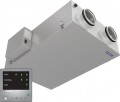Number of fan speeds
The number of speeds at which the fans of the air ventilation unit can operate.
The presence of
several speeds allows you to choose the actual performance of the installation, adjusting it to the specifics of the current situation: for example, in a production room, you can reduce the ventilation intensity during the night shift, where there are fewer people than in the daytime. And the more speeds provided in the device (with the same performance range) — the more choice the user has, the easier it is to find the mode that best suits current needs.
Note that if the minimum and maximum of the air flow are indicated in the specs, but the number of speeds is not given, this does not necessarily mean smooth adjustment. On the contrary, most often such models are regulated traditionally, in steps, but for some reason, the manufacturer decided not to specify the number of speeds in the characteristics.
Maximum noise level
The noise level produced by the air ventilation unit in normal operation.
This parameter is indicated in decibels, while the decibel is a non-linear unit: for example, a 10 dB increase gives a 100 times increase in sound pressure level. Therefore, it is best to evaluate the actual noise level using special tables.
The quietest modern ventilation units produce about
27–30 dB — this is comparable to the ticking of a wall clock and allows you to use such equipment without restrictions even in residential premises (this noise does not exceed the relevant sanitary standards). 40dB is the daytime noise limit for residential areas, comparable to average speech volume. 55–60 dB — the norm for offices, corresponds to the level of loud speech or sound background on a secondary city street without heavy traffic. And in the loudest, they give out 75–80 dB, which is comparable to a loud scream or the noise of a truck engine. There are also more detailed comparison tables.
When choosing according to the noise level, it should be taken into account that the noise from the air movement through the ducts can be added to the noise of the ventilation unit itself. This is especially true for centralized systems (see "System"), where the length of the ducts can be significant.
Remote control
The presence
of a remote control in the delivery set of the air ventilation unit.
This configuration is provided in most decentralized models (see "System"). However, it is often found in centralized ones. The possibility of a remote control provides additional convenience for the user — you do not need to approach the unit every time. In addition, many control functions can be transferred to the remote control, making the installation itself more compact (this is true for the mentioned decentralized equipment, which has a rather small size).
Note that the remote control can be both portable and wall-mounted, designed to be permanently in one place (like a wall light switch).
EC fan
The presence
of an EC fan(fans) in the design of the air handling unit.
This term refers to fans with synchronous brushless motors, also known as EC motors. Such motors are more advanced than traditional asynchronous ones: in particular, they provide very uniform rotation, allow precise control of speed, have high efficiency, and generate almost no heat (which is extremely important in the presence of a cooler, see "Features"), and also efficiently operate over a wide temperature range. In addition, the noise level of such motors is noticeably lower, and the service life is longer. The main disadvantage of EC fans is the traditionally high price.
Power consumption in ventilation mode
The electrical power consumed by the supply and exhaust unit in normal operating mode (for models with adjustable performance — at maximum speed) can help determine the connection requirements for the unit and estimate the cost of operation in terms of electricity bills. It should be noted that for models with an electric reheater (see "Reheater type"), this refers only to the power of the ventilation system, while the power of the reheater is provided separately (see above). Therefore, the total energy consumption during full operation will correspond to the sum of these power values.
The power consumption can also be used to some extent to assess the unit's performance: "power-hungry" units usually provide a corresponding airflow.

